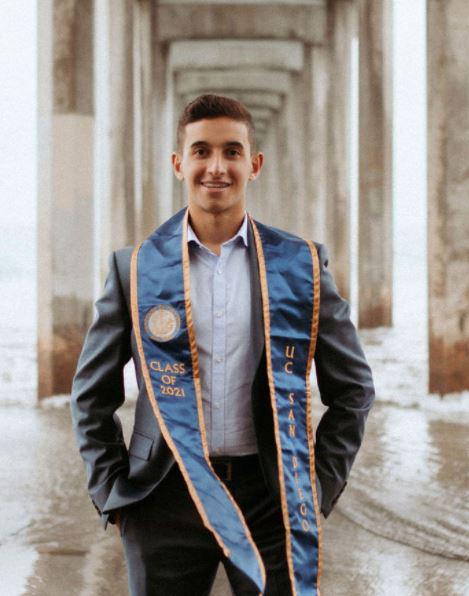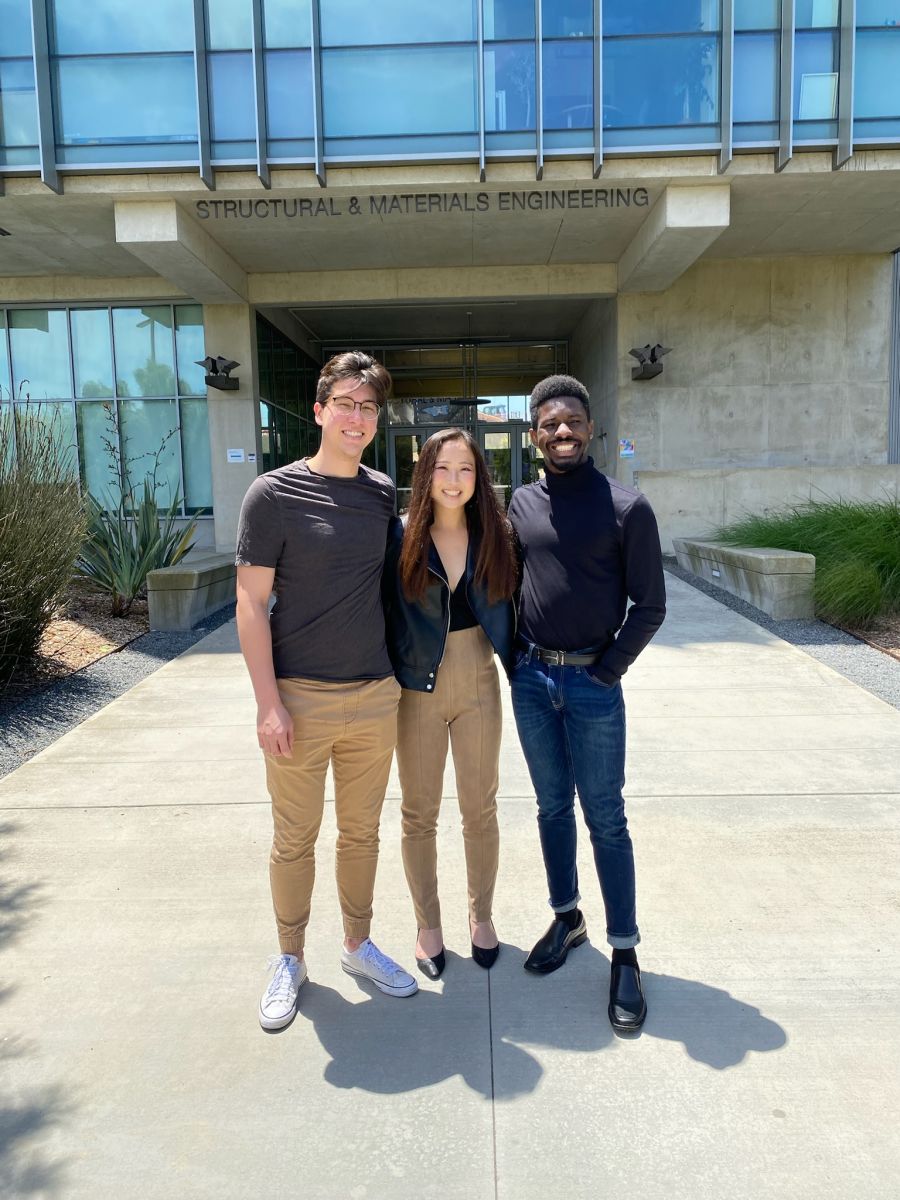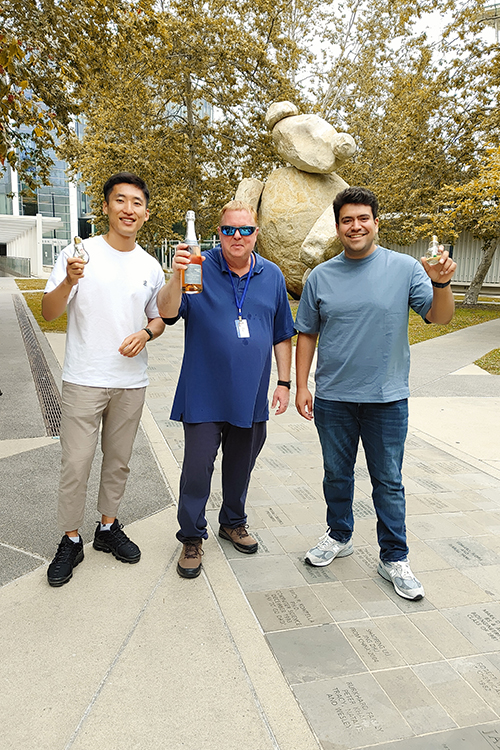News Release
UC San Diego Students Win National Entrepreneurship Challenge in Nanotechnology
July 27, 2022--Two student teams at UC San Diego—led by master’s student Amer Yaghi and by senior undergraduate Lauren Takiguchi, both of the Jacobs School of Engineering—recently placed first and second in the Nanotechnology Entrepreneurship Challenge (NTEC), an annual contest that teaches budding entrepreneurs the ins and outs of founding a nanotechnology startup.
Under the guidance of Yves Theriault, program manager for education and outreach at the Qualcomm Institute (QI), the UC San Diego teams competed with others from 16 sites across the U.S. They had seven weeks to find teammates and brainstorm an idea for an invention with societal impact. In that time, they had to seek out and interview potential customers, incorporate feedback into their design and make a final pitch, just as they would in a real-world scenario.
“I could tell that Amer and Lauren had the enthusiasm and commitment to do whatever it took to produce that final deliverable,” said Theriault. “The students worked hard to implement what they learned, and, at the end of the day, they had something great.”
A panel of local businesspeople, including one former NTEC contestant, judged the teams’ final proposals. This was the first year the challenge was held at the national level.
Nanotechnology for greater personal health
 |
| First-place winning team lead Amer Yaghi, here shown by Scripps Pier. |
To help get them started, each NTEC team had access to a small amount of seed funds and state-of-the-art nanotechnology facilities at one of 16 National Nanotechnology Coordinated Infrastructure (NNCI) satellite sites funded by the National Science Foundation. The UC San Diego teams leveraged Theriault’s expertise through the San Diego Nanotechnology Infrastructure (SDNI) at QI.
Yaghi, who was studying nanoengineering in the research lab of Assistant Professor Sheng Xu in UC San Diego’s Department of Chemical and Nano Engineering, and his teammates—Tom Park, a doctoral student in nanoengineering; Abdulhameed Abdal, mechanical engineering; and Elio Li, materials science—leveraged the Xu lab’s work with wearable electronics to address problems faced by Parkinson’s patients. Parkinson’s, which is associated with a drop in neurotransmitter dopamine, afflicts patients with changes in mood, depression and problems with memory and mobility.
Since these symptoms make it difficult to keep up with doctor’s appointments or take medication in a timely manner, Yaghi and his team proposed a biomedical device that could both monitor and treat Parkinson’s disease patients—a so-called “closed loop” design pioneered by Xu. Modeled after a patch that could be worn directly on the skin, the device would use the power of nanotechnology to integrate multiple layers of sensors at a small enough scale that the product’s soft, flexible material would move naturally and inconspicuously with the body.
Armed with sensors like nanoscopic accelerometers and gyroscopes, the device could enable doctors to measure the progression of Parkinson’s by recording the speed of a person’s movements and their physical orientation. In cases with a person with a higher genetic risk of developing the disorder, medical professionals could use these features to get a head start on diagnosing Parkinson’s in its earliest stages.
For patients already diagnosed with Parkinson’s, the device’s design includes a bed of microneedles, each finer than a human hair, for injecting pharmaceutical drugs in a nearly painless process.
“The cool thing about the device is, in reality, it doesn’t only have to be used for Parkinson’s,” said Yaghi. “You can change the type of drug delivered and use it for other diseases.”
To the team’s knowledge, this is the first proposed, wearable device for remotely diagnosing and treating Parkinson’s.
A different target
 |
| The OA-Away team poses in front of the Structural & Materials Engineering building on UC San Diego campus. From left to right: George Gaus, team lead Lauren Takiguchi and Bolarin Lawrence. |
The second-place winning team, led by Takiguchi and including undergraduate students George Gaus, biochemistry, and Bolarin Lawrence, nanoengineering, also pitched a wearable device, this time targeting osteoarthritis. Called “OA-Away,” the proposed design features a transdermal patch that capitalizes on a drug delivery method using liposomes—tiny bubble-shaped structures with a hollow interior for storing pharmaceuticals—to target specific joints affected by osteoarthritis.
Like Yaghi’s team, Takiguchi and her classmates arrived at the submitted design through a process of trial and error. Initially, the students had considered using techniques such as DNA origami, in which scientists can fold single strands of DNA into different shapes to ferry pharmaceuticals to target sites inside the body. After speaking with pharmacists and other healthcare professionals, however, the team settled on liposomes as a U.S. Food and Drug Administration-approved technology that had received a flood of funding as part of the vaccine effort for COVID-19. It would be just as effective as other methods and much easier to bring to market.
“A lot of our training in school is focused purely on science,” said Takiguchi. “NTEC was helpful because it taught us to look at factors that would make our product a reality.”
With just under two months to bring their project together, the OA-Away team got as far as making and testing their liposomes in the lab, a first-time achievement for their group. They placed only a tenth of a point behind the leading team.
Investing in the entrepreneurs of the future
In evaluating the pitches, Matthew Hull, director of the NNCI Innovation and Entrepreneurship Committee says, the committee judged not so much the progress the students had made toward a final product, but the degree to which they had learned how to listen and adapt to the needs of prospective customers.
“I founded a nanotechnology company within a month of starting my Ph.D. program back in 2007,” said Hull. “As an entrepreneur, I wanted to share the lessons I learned through trial and error with the next generation.”
Since the announcement of the contest winners, both Yaghi and Takiguchi graduated with their master’s and bachelor’s degrees, respectively. Yaghi started a new career with an eye toward wearable devices, while Takiguchi, building on an interest in teaching, joined a small SDNI team working to bring nanotechnology to San Diego’s public schools. She now works alongside Theriault, helping middle and high school teachers incorporate nanoscience into their lesson plans and connecting students to nanotechnology at QI.
Each has said that their experience mentoring under Theriault and, in Yaghi’s case, Xu as well, changed the way they think about collaborating and sharing knowledge. Both mentors dedicated hours of their time to their teams, imparting research insight, business savvy and the resources the students needed to excel.
“As a mentor, you want to help people,” said Theriault, who sits on the NNCI Innovation and Entrepreneurship Committee alongside Hull. “It’s always rewarding when people say, ‘Thank you so much for mentoring us, you made a difference.’ So I guess I did my job.”
Media Contacts
Liezel Labios
Jacobs School of Engineering
858-246-1124
llabios@ucsd.edu
Xochitl A. Rojas-Rocha
Calit2
858-534-0858
xrojasrocha@ucsd.edu
